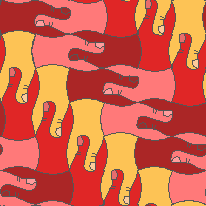
Tiles are classified into periodic and aperiodic. Periodic tiles are those good for background images, that is, the pattern repeats. Aperiodic tiles can fill a plane, but without repeating the pattern. My favourite tiles are those who can fill the plane both periodically and aperiodically, but I've got a bit of everything.
Periodic tiles
 |
This is one of the first tilings I made. It's based on a famous pentagonal tile with equal sides and a right angle (not the one on the background) that can fill the plane with an interesting symmetry. These tiles keep the same symmetry, but where have the pentagons gone? (If you'd like to see a page with this background to see it more clearly, click here) |
 |
This pattern makes an interesting puzzle. Cut the screaming girls on
paper (there are six looking to the right and six looking to the left),
and try to do this figure. It's very hard!
This pattern is based on a tile by Roger Penrose. |
 |
 |
A tesselation based on a pentagonal tile by Marjorie Rice. (Yes, pentagonal
tiles are my weakness).
This fish exists really in nature, it's called a butterfly fish. |
 |
I can't make an image suitable for background with this pattern because it would be too big. It's based on my favourite pentagonal tile. (You can go there to see the full pattern) |
 |
In most tesselations the individual tiles are too "individual": they can be perfectly understood out of the whole pattern, and it may be visually interesting to see them fitting into each other, but it doesn't add any new meaning. This pattern is different: most people probably wouldn't understand a separate tile, but when they're all together, the meaning is obvious. |
Tiles that can fill the plane periodically and aperiodically
| This tile is versatile enough to fit both horizontally and vertically.
You can combine horizontal and vertical rows as you like in an infinite
number of ways, both periodically and aperiodically (spirals, for example).
Believe it or not, this bird existed once. It's a prehistoric bird called Dyatrima. It was one of the biggest birds ever, it couldn't fly and it's usually considered carnivorous. |
 |

Look at these two patterns. At first sight, they look like they're made with a tile that can fill the plane in two different ways. But there's a difference between the tiles of these two patterns. Can you find it? It's possible to combine both patterns to make an infinite number of new patterns, both periodic and aperiodic, the same as the last tesselation. |
Aperiodic tiles
 |
Aperiodic tiling based on six tiles by Raphel Robinson. |
| Aperiodic tiling based on the famous aperiodic tiles with five-fold symmetry by Roger Penrose. |
Some tesselations are made by tiles that get smaller and smaller (the
best known examples are the "Circle limits" by Escher). My contributions
to this kind of patterns aren't worth much artistically, but they are mathematically
interesting.
 |
The only tesselation I know in which every tile is in contact with
an infinite number of other tiles.
The tiles, if you don't understand them, intend to be medusas. |
| A tesselation based on the golden rectangle. (If you don't know what a golden rectangle or the golden number is, I recommend reading my comments on the proportions of the Great Pyramid). |
If you like tesselations, I'm certain you love Escher. If you'd like
to see another aspects of Escher's art, among some of my curious ideas,
click here.